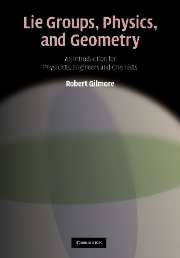Book contents
- Frontmatter
- Contents
- Preface
- 1 Introduction
- 2 Lie groups
- 3 Matrix groups
- 4 Lie algebras
- 5 Matrix algebras
- 6 Operator algebras
- 7 EXPonentiation
- 8 Structure theory for Lie algebras
- 9 Structure theory for simple Lie algebras
- 10 Root spaces and Dynkin diagrams
- 11 Real forms
- 12 Riemannian symmetric spaces
- 13 Contraction
- 14 Hydrogenic atoms
- 15 Maxwell's equations
- 16 Lie groups and differential equations
- Bibliography
- Index
9 - Structure theory for simple Lie algebras
Published online by Cambridge University Press: 05 September 2012
- Frontmatter
- Contents
- Preface
- 1 Introduction
- 2 Lie groups
- 3 Matrix groups
- 4 Lie algebras
- 5 Matrix algebras
- 6 Operator algebras
- 7 EXPonentiation
- 8 Structure theory for Lie algebras
- 9 Structure theory for simple Lie algebras
- 10 Root spaces and Dynkin diagrams
- 11 Real forms
- 12 Riemannian symmetric spaces
- 13 Contraction
- 14 Hydrogenic atoms
- 15 Maxwell's equations
- 16 Lie groups and differential equations
- Bibliography
- Index
Summary
In this chapter we continue the development begun in the previous chapter. These two chapters focus on determining the structure of a Lie algebra and putting it into some canonical form. In the previous chapter we determined the types of subalgebras that every Lie algebra is constructed from. In this chapter we put the commutation relations into a standard form. This can be done for any Lie algebra. For semisimple Lie algebras this standard form has a very rigid structure whose usefulness is surpassed only by its beauty.
Objectives of this program
In the previous chapter we studied the commutation relations of a Lie algebra through its regular representation. This study was carried out using as a tool the Cartan–Killing inner product. As far as possible, this was the only method used. In the present chapter we introduce a second powerful tool from the theory of linear vector spaces. This is the eigenvalue decomposition. This tool is introduced in an attempt to find standard forms for the commutation relations. If a standard form is available then the properties of a Lie algebra, as well as its identification (classification), can be determined at sight.
The eigenoperator decomposition is effected by computing and studying a secular equation determined from the matrix of the regular (or any other matrix) representation of the Lie algebra.
- Type
- Chapter
- Information
- Lie Groups, Physics, and GeometryAn Introduction for Physicists, Engineers and Chemists, pp. 139 - 158Publisher: Cambridge University PressPrint publication year: 2008



